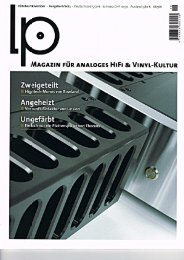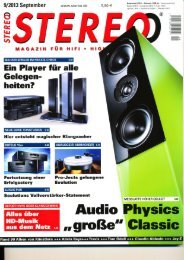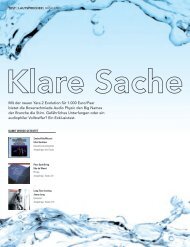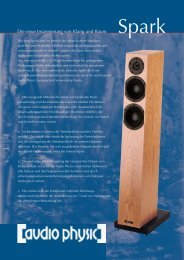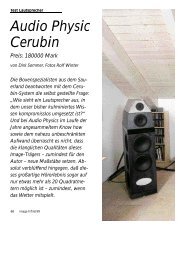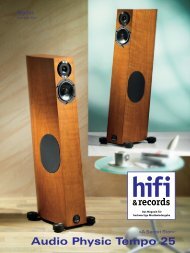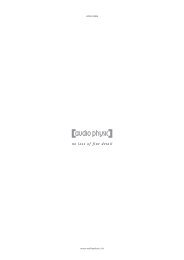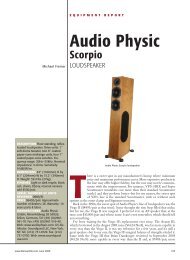Avanti III loudspeaker - Audio Physic
Avanti III loudspeaker - Audio Physic
Avanti III loudspeaker - Audio Physic
You also want an ePaper? Increase the reach of your titles
YUMPU automatically turns print PDFs into web optimized ePapers that Google loves.
Specifications<br />
Description: 31⁄2-way, floorstanding, moving-coil <strong>loudspeaker</strong>. Driveunits:<br />
one 1“ ring-radiator tweeter, two 5“ aluminum-cone midrange<br />
drivers with Active Cone Damping (ACD), four 61⁄2“ woofers. Crossovers:<br />
200Hz, 500Hz, 2.2kHz. Frequency response: 28Hz-40kHz, -3dB.<br />
Nominal impedance: 4 ohms. Sensitivity: 89dB/W/m. Power rating:<br />
250W.<br />
Dimensions: 44“ H by 71⁄2-91⁄2“ W by 16“ D. Weight: 92 lbs each.<br />
Finishes: Maccassar Ebony; add $1000 for cherry or maple.<br />
Serial numbers of units reviewed: 739A/B.<br />
Price: $10,995/pair. Approximate number of dealers: 35.<br />
Manufacturer<br />
<strong>Audio</strong> <strong>Physic</strong>, Gallbergweg 50, 59929 Brilon, Germany.<br />
Web: www.audiophysic.de.<br />
US distributor: Immedia, 1717A Fourth Street, Berkeley, CA 94710.<br />
Tel: (510) 559-2050. Fax: (510) 559-1855.<br />
Web: www.immediasound.com.<br />
Associated Equipment<br />
Analog sources: Simon Yorke, Acoustic Signature Final Tool turntables;<br />
Graham 2.0, Immedia RPM-2, Triplaner VI, Rega RB300 (Incognito<br />
rewired), SME 309 tonearms; Lyra Helikon, Helikon mono, Clearaudio<br />
Insider, Transfiguration Temper Supreme, Sumiko Celebration cartridges.<br />
Digital source: Marantz SA-1 SACD player.<br />
Preamplification: Hovland HP-100, <strong>Audio</strong> Research Reference Phono.<br />
Power amplifiers: Hovland Sapphire (prototype), Musical Fidelity Nu-<br />
Vista 300.<br />
Loudspeakers: Sonus Faber Amati Homage.<br />
Cables: Phono: Hovland Music Groove DIN/RCA and RCA/RCA. Interconnect:<br />
Harmonic Technology Pro-Silway II and Magic. Speaker: Harmonic<br />
Technology Woofer. AC: JPS Labs, Electra Glide Fatboy, PS <strong>Audio</strong> Lab,<br />
Wireworld Electra Series <strong>III</strong>.<br />
Accessories: PS <strong>Audio</strong> Power Plant P300 and P600 AC regenerators,<br />
Sounds of Silence Vibraplane active isolation platform, Symposium Tungsten<br />
Rollerblocks, Grand Prix <strong>Audio</strong> Monaco amplifier stands, Walker<br />
motor drive, Finite Elemente Pagode and Zoethecus equipment stands,<br />
A.R.T. Q dampers, Walker Valid Points, ASC Tube Traps, Shakti Stones and<br />
On-Lines, RPG BAD and Abffusor panels.<br />
Michael Fremer<br />
Measurements<br />
The <strong>Audio</strong> <strong>Physic</strong> <strong>Avanti</strong> <strong>III</strong>‘s B-weighted sensitivity was a fairly high<br />
88.6dB(B)/2.83V/m, fractionally but insignificantly below the specified<br />
89dB/W/m. However, its plot of impedance magnitude and phase<br />
against frequency (fig.1) revealed it to be a „4 ohm“ design; ie, it<br />
actually draws 2W from the amplifier to raise the rated sound-pressure<br />
level. The speaker‘s minimum impedance is around 3.5 ohms in the low<br />
bass and upper midrange, which should not present problems to good<br />
4 ohm-rated amplifiers. While the phase angle is generally benign, there<br />
is a coincidence of low impedance and high phase angle around 20Hz.<br />
Fortunately, with the exception of classical organ recordings, there is<br />
rarely any significant music energy down there — but the <strong>Avanti</strong> would<br />
hardly be the speaker of choice for fans of organ CDs, in any case.<br />
Fig.1 <strong>Audio</strong> <strong>Physic</strong> <strong>Avanti</strong> <strong>III</strong>, electrical impedance (solid) and phase (dashed).<br />
(2 ohms/vertical div.)<br />
The traces in fig.1 are free from discontinuities that might otherwise indicate<br />
the presence of cabinet resonances. Unfortunately, an equipment<br />
failure meant I could not perform any accelerometer measurements of<br />
the <strong>Audio</strong> <strong>Physic</strong>‘s beautifully curved enclosure walls. However, listening<br />
to the cabinet with a stethoscope while the speaker reproduced<br />
swept sinewaves and pink noise indicated that it was basically free from<br />
vibrational resonances.<br />
The <strong>Avanti</strong>‘s downward-firing ports mean that the exact tuning of the<br />
reflex-loaded woofers will change according to the gap between the<br />
base of the speaker and the floor. For my measurements, I placed the<br />
speaker‘s feet on 1“ blocks of Styrofoam, which gave the saddle centered<br />
at 29Hz in the fig.1 magnitude trace, indicating the ports‘ tuning<br />
frequency. But there are some other twists in the traces between 40Hz<br />
and 160Hz that suggest something else is going on.<br />
On the left side of fig.2 are shown the individual responses of the sidemounted<br />
woofers and the downward-firing ports, taken in the nearfield;<br />
ie, with the microphone capsule very close to the radiating element. (To<br />
measure the port, I placed the mike on the floor, adjacent to the edge of<br />
the cabinet.) As expected, the minimum in the woofer response at 29Hz<br />
coincides with both the maximum in the port output and the frequency<br />
of the bass saddle in fig.1.



